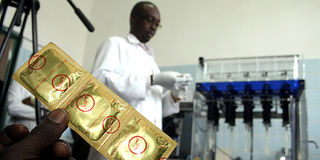Demand for condoms doubles to 15 million

A sample of a Government-issued condom being examined at the Kenyatta National Hospital Laboratory. PHOTO/ CHRIS OJOW
What you need to know:
- But shortage looms in government centres over importation delays
Demand for condoms has doubled from seven million to 15 million in the past year.
At the same time, a shortage of government supplied condoms is looming due to delays in importing them.
The National Aids/STD Control Programme head, Dr Nicholas Muraguri, said procurement hitches had led to the shortage.
However, Dr Muraguri said 300 million condoms are expected in the country this month.
“We expect the first of the five batches within the month,” he said.
He added that the government was redistributing condoms from areas of low use to those of high demand.
A spot check at three major distribution centres in Nairobi — Ngara, Dagoretti, and Westlands city council health centres — indicated low stocks or none at all.
A manager at one of the centres said that supply from Asia, where the condoms are imported from, was low and attributed this to next month’s Fifa World Cup in South Africa, where, he claimed, most exports were headed.
However, Dr Muraguri explained that the delay may have occurred between the importers, the United Nations Fund for Population, and manufacturers who now require payment before goods are shipped.
A source at an international non-governmental organisation said the shortage started three months ago.
But Dr Muraguri said there was no cause for alarm because over 50 million condoms were released between November and February this year.
In any case, he said, Population Services International, which deals with the Trust brand of condoms, supplies about 30 million pieces annually.
The government is the main supplier of condoms, at 180 million pieces annually.
Dr Muraguri said that in the past five years, the rate of consistent condom use among the youth aged between 15 and 24 years had jumped from 25 per cent to 75 per cent.
“We are also seeing people aged around 45 using condoms. This has put pressure on supplies and we may have to increase our estimates.”
A study conducted at the University of Nairobi and released last month showed increased use of condoms among university students.
“Condom use by young men ‘at last sex with a casual partner’ has shown strong and steady progress, increasing from 52 per cent in 2003 to 69 per cent in 2007 and 75 per cent now,” said Dr Muraguri.



